John Hurrell – 22 January, 2013
In some ways it is a shame Moore enjoys editing and digitally manipulating moving image so much. I'd rather focus on his agile ruminations on the page than on a screen, treating them as poetry - savoring his dextrous conceptual twists and doubling under phrasings without accompanying visual distraction.
Alright, here’s Tahi Moore from a piece of writing he did about five years ago that’s on the Hopkinson Cundy website promoting their artists. He starts:
‘What can I say? Oh yeah too much….okay ha ha could be right hang on….But blah blah there’s always too much? What does that mean, what a bunch of shit. Oh no, it makes sense…Overload’s fine in itself it works all the time, but….’
It would seem Moore has a problem with condensing and paring down, that he worries (or pretends to worry, or then denies) that there is too much crammed in. Even if a viewer as besotted with film as he is has the patience and time to link up the many allusions and stated cinematic, geographic, social and philosophical references in the sculpture, paintings, photos and downloaded and directly filmed videos (with or without running subtitles) - and even if they are convinced he is analysing in an interesting manner the particularities of narrative structure (how meaning is assembled), looking at (as one video puts it) ‘structure outside narrative, narratives of structure, language repeating itself, structure following language (and) language repeating something’ - in the end you are overwhelmed by his (as another states) ‘tak(ing) on an over populated mind’.
So in Hopkinson Cundy’s new premises in Putiki St, opposite Two Rooms, Moore has his work filling the two galleries. The inner smaller (darker) room has mainly duratrans prints in light boxes (five) on the floor, while the outer larger (lighter) space has sculpture, paintings and videos (seven) on monitors. The ‘over population’ is not so much a cluttering of items in the space - in fact Moore’s placement is elegant - but a scattering, an abundance of repeated sections and phrases, within the video loops, two of which are longer than the others, but not nearly as long as those in his last show.
With all the interconnections spread apart there is a sense of something neural - linear firings with invisible ganglions and synaptic jumps, a web of associations spread wide - based on a core Mastermind approach obsessed with film history minutiae. But those professorial (or Godardian) minutiae are really an excuse (a catalyst) for thinking and writing about thinking and writing.
My view is that writing is Moore’s main talent, his most engaging and fluid means of expressing his own mental toing and froing, though with the video construction he has achieved something distinctive. In some ways it is a shame he enjoys editing and digitally manipulating moving image so much. I’d rather focus on his agile ruminations on the page than on a screen, treating them as poetry - savoring his dextrous conceptual twists and doubling under phrasings without accompanying visual distraction. His appropriated duratrans on lightboxes, from European films, I prefer textless.
Yet some sections of his moving image components are hauntingly beautiful - when you’ve picked through a lot of stuff to find them - especially rolling landscapes seemingly filmed around Cornwall Park that appear to allude to Barry Lyndon or Blow Up, or shots of dappled light raking across tweed jackets and other garments hanging on hooks in a darkened hall.
There’s also the surreal humour of cars or skiers flying at high altitudes over castles or rocky mountain slopes. Or with paintings, his ‘stolen’ chunks of DIY ‘chalet’ tourist resort wall referencing Chamonix and Mount Blanc. Or with sculpture a timber pyramid last seen in Te Tuhi, that now relates to Mayan ruins at Isla Mujeres. Though the ideas he textually embeds into these handmade objects are given high profile there’s a sense that he basically enjoys the physical act of making things and that the ‘excuse’ or narrative concept comes well down the track (often not relating to the image) because mental gymnastics is fun anyway.
That would explain why sometimes the same work (usually sculpture) turns up in different shows in different contexts. Consequently with Moore’s videos (all of them silent) there is the strong sense of a dominant interiority that emphasises dualism, a running stream of post-mentalese internal dialogue that ignores whatever the body is doing (or what its camera-‘eyes’ are seeing) wherever it may be - speculative thought dominating over (and quite separate from) muscular action.
John Hurrell
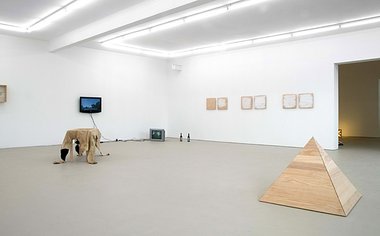
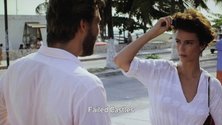



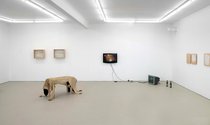
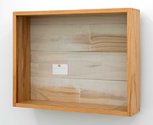
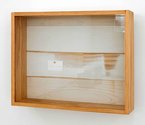
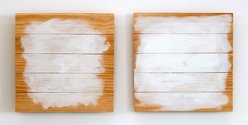
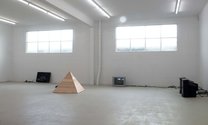
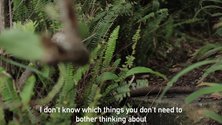
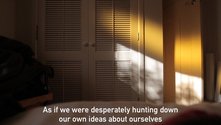
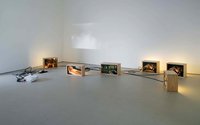
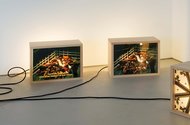
 Two Rooms presents a program of residencies and projects
Two Rooms presents a program of residencies and projects Advertising in this column
Advertising in this column



This Discussion has 0 comments.
Comment
Participate
Register to Participate.
Sign in
Sign in to an existing account.